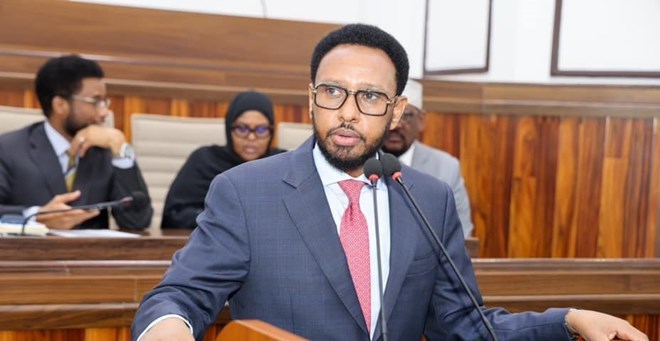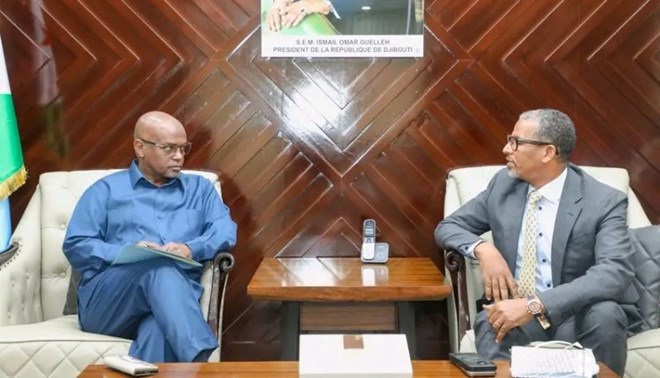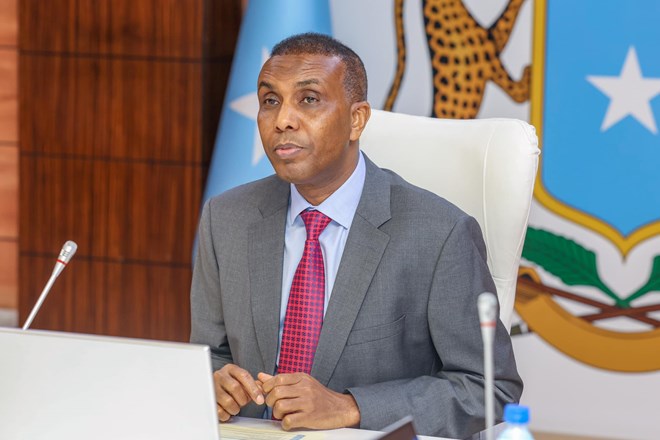
Latest News Regarding
Horn of Africa
More Concern Over a Possible Ethiopia-Eritrea Conflict
More Concern Over a Possible Ethiopia-Eritrea Conflict
Source: Foreign Policy published on 12 March 2025 an analysis titled “Stop the Next Ethiopia-Eritrea War Before It Begins” by Payton Knopf and Alexander Rondos.
The deterioration of the political and security situation in Ethiopia’s Tigray Region is dry tinder waiting for a match that could ignite a war between Ethiopia and Eritrea.
Addis Ababa accuses Asmara of undermining the Pretoria Agreement that ended the war in Tigray Region and of supporting insurgent groups elsewhere in Ethiopia. Asmara perceives landlocked Ethiopia’s calls for access to the Red Sea as a casus belli and forerunner for efforts to return Eritrea to Ethiopian sovereignty.
Ethiopia’s Somali and Afar leaders hold iftar to end territorial dispute
Ethiopia’s Somali and Afar leaders hold iftar to end territorial dispute

Source: Hiiraan Online, Thursday March 13, 2025

Somali and Afar regional leaders, accompanied by religious figures, walk together in a show of unity during a reconciliation event in Jigjiga. Mogadishu (HOL) — Ethiopian authorities from the Somali and Afar regions have launched a new reconciliation push to end one of the country’s most protracted and violent territorial disputes.
Leaders from both regions, whose armed forces have repeatedly clashed over contested land, gathered for a communal iftar—an attempt at diplomacy amid a conflict that has killed hundreds, displaced thousands, and turned stretches of Ethiopia’s Sitti Zone into a no-man’s land.
For the first time in months, 65 Afar officials travelled to Jigjiga to share a Ramadan meal with their Somali counterparts, while Somali leaders are set to attend a similar event in the Afar region. The hope is that a shared table can do what ceasefire agreements and federal interventions have repeatedly failed to accomplish: end the war over the border.
“In past years, Ramadan has often seen an increase in violence, but this time, we are using it to bring people together,” Abdiqadir Rashid Duale, security chief for the Somali regional government, told the BBC Somali Service.
The next step, he added, is facilitating the return of displaced residents, after which land ownership disputes and other legal claims will be addressed through formal mechanisms.
For decades, the Somali Issa clan and Afar communities have fought over land along their jagged border. The three contested kebeles—Adaytu, Undufo, and Gedamaytu—are home to ethnic Somalis who insist they belong to the Somali region, while Afar authorities claim the land as their own.
The disputed areas sit on a lifeline of trade and survival—a corridor linking Addis Ababa to Djibouti, Ethiopia’s main export route. The Awash River runs through it and is essential for both Somali pastoralists and Afar herders. Whoever controls the land controls the water, the roads, and the economy.
Despite multiple peace efforts, violent clashes have continued.
In April 2024, the Ethiopian Islamic Affairs Supreme Council brokered a ceasefire. By June, fighting had resumed—heavy clashes in the Sitti Zone and Afar’s Yangudi district left scores dead. The Ethiopian Human Rights Commission pleaded for calm, warning that the tit-for-tat violence was spiralling out of control.
The attacks prompted Somali Regional President Mustafa Mohammed Omar Agjar to travel to Sitti Zone in mid-August, where he visited victims of the clashes in Undufo and Danlahelay, surveying the devastation firsthand.By September 2024, the federal government stepped in again. Deputy Prime Minister Temesgen Tiruneh’s National Committee declared a “cessation of hostilities,” deployed troops, and took control of conflict zones. For now, the guns are quiet.
The Somali-Afar conflict is deepened by Ethiopia’s ethnic federalism, a system that gave both regions autonomy—but also deepened competition over borders.
In 2014, the federal government struck a deal: the contested towns would be part of the Afar region but granted special status for Somali residents. The Somali leadership withdrew the agreement in 2019, saying it was unconstitutional. The result? A political vacuum filled with bullets.
In April 2023, the Ethiopian government tried another approach—disbanding regional special forces and integrating them into national security forces. The move was meant to curb the influence of ethnic militias, but in actuality, it left both regions to rely on informal fighters, tribal elders, and armed civilian groups.
While local officials hail the recent iftar diplomacy as a step toward reconciliation, analysts warn that peace in the Somali-Afar borderlands will require more than symbolic gestures. Economic investment in the disputed territories is essential to stabilize communities and reduce reliance on resources that have fueled tensions for decades. A formal arbitration process must follow, resolving land ownership disputes through legal mechanisms rather than sporadic ceasefires that collapse under renewed violence.
Horn of Africa countries greatly in need Peace, Stability and Development
Horn of Africa countries greatly in need Peace, Stability and Development
International mass media predict possible war again soon between Ethiopia-Eritrea countries. Why? There is no acceptable reason the world can accept! If this happens, the United Nations Security Council, and African Union have to take strong action!!! Horn of Africa countries greatly needs peace, tranquillity, rule law and regional development.
Abdillahi Jama,
Somali International Rehabilitation Centre (SIRC), www.sirclund.se
South Sudan Facing New Outbreak of Conflict
South Sudan Facing New Outbreak of Conflict
Source: The International Crisis Group published a statement dated 7 March 2025 titled “South Sudan on the Precipice of Renewed Full-blown War.”
Tensions are rising quickly between the forces that support President Salva Kiir and those who back Vice President Riek Machar. The civil war raging in neighboring Sudan is contributing to the tension in South Sudan, where violence is likely to escalate. South Sudan could easily slip back into full scale conflict and ethnic bloodletting.
Three wanted over murder of Scottish man in Kenya
Three wanted over murder of Scottish man in Kenya

Source: BBC, Saturday March 8, 2025

Samuel Musembi Kamitu, left, Benard Mbunga Mbusu, centre, and Alphonse Munyao Kilewa, right, are wanted by Kenyan police in connection with Mr Scott’s death
Police in Kenya have named three men wanted in connection with the murder of a Scottish businessman whose body was found in a sack of pineapples.
Campbell Scott was found dead in a forest 60 miles (96.5km) from Nairobi after he went missing from his hotel on 16 February.
The country’s Directorate of Criminal Investigations (DCI) has released images of the men, who they believe are linked to the “brutal murder” of the 58-year-old.
They have been named as Benard Mbunga Mbusu, Samuel Musembi Kamitu and Alphonse Munyao Kilewa, also known as “Edu”.
The DCI posted a statement on X asking for anyone with information on their whereabouts to contact them.
Two other men appeared in court accused of using Mr Scott’s bank cards to withdraw money on Saturday.
Mr Scott, from Dunfermline in Fife, was a senior director at the credit scoring firm Fico and had been attending a conference at the JW Marriott Hotel in Nairobi.
He went missing after failing to meet colleagues to deliver a presentation having visited a nightclub.
His body was found in Makongo Forest with his hands bound.
A number of arrests have been made in connection with the investigation.
Police initially arrested two men – a taxi driver and a nightclub waiter – who are believed to have been among the last to see him alive.
Then on Saturday two other men were arrested in Mombasa, 301 miles (485km) from Nairobi on Kenya’s Indian Ocean coast.
Officers believe Mr Scott visited a house belonging to one of the men, where he was killed.
They allege that the same man withdrew money from Mr Scott’s account at three different locations, working with the second suspect.
A court in Nairobi agreed that police could hold the men for 21 days while the investigation into his death continues.
A post-mortem examination into his death proved “inconclusive”.
Pathologists said samples would be submitted for toxicology testing after it was determined the injuries sustained by Mr Scott were “too minor” to have caused his death.
The DCI has asked Interpol to help track Mr Scott’s mobile phone and debit and credit card transactions.
Two dead, 186 missing after four boats sink off Yemen and Djibouti: UN
Two dead, 186 missing after four boats sink off Yemen and Djibouti: UN

Source: Aljazeera, Saturday March 8, 2025

Despite a nearly decadelong civil war, Yemen remains a major route for tens of thousands of migrants, mostly from Ethiopia, trying to reach Gulf countries for work [File: Fawaz Salman/Reuters]
Four boats carrying migrants from Africa have capsized in waters off Yemen and Djibouti, leaving at least two people dead and 186 missing, according to the United Nations migration agency.
A spokesperson for the International Organization for Migration (IOM) said on Friday that two of the boats capsized off Yemen late on Thursday.
Tamim Eleian said two crew members were rescued, but 181 migrants and five Yemeni crew remain missing.
The IOM chief of mission in Yemen said the majority of those onboard were believed to be Ethiopian migrants and five were thought to be Yemeni crew members. At least 57, from both boats, were women.
“We are working with authorities to see if we can find any survivors, but I’m afraid we may not have any,” Abdusattor Esoev told the AFP news agency.
Two other boats capsized off the tiny African nation of Djibouti about the same time, Eleian said. Two bodies of migrants were recovered, and all others on board were rescued.
Despite a nearly decadelong civil war, Yemen remains a major route for migrants and refugees from East Africa and the Horn of Africa trying to reach Gulf countries for work. Hundreds of thousands of people attempt the crossing each year.
To reach Yemen, people are taken by smugglers on often dangerous, overcrowded boats across the Red Sea or Gulf of Aden.
The numbers of people making it to Yemen reached 97,200 in 2023 – triple the number in 2021.
But last year, the number dropped to just under 61,000 amid increased patrols of the waters, according to an IOM report this month.
The IOM said 558 people died along the route in 2024.
In January, 20 Ethiopians were killed when their boat capsized off Yemen.
Over the past decade, at least 2,082 people have disappeared along the route, including 693 known to have drowned, according to the IOM.
About 380,000 migrants are currently in Yemen.
Source: Al Jazeera and news agencies
Oil Production Resumes in South Sudan, But Economy and Chinese Oil Companies Struggle
Oil Production Resumes in South Sudan, But Economy and Chinese Oil Companies Struggle
Source: The South China Morning Post published on 2 March 2025 an article titled “How Chinese Firms Are Holding Out Hope for South Sudan’s Oil Lifeline” by Jevans Nyabiage.
After a year of interrupted oil production, which provides 90 percent of South Sudan’s revenue, it resumed early this year. While this is an important boost to South Sudan’s economy, inflation rages and production will not return to pre-shutdown levels. Chinese companies with significant stakes in the oil sector are hoping they can return to profitability.
Democracy Index 2024 and Africa
Democracy Index 2024 and Africa
Source: The Economist Intelligence Unit has just released its “Democracy Index 2024.” The index provides a snapshot of the state of democracy in 165 independent states and two territories. The index is based on five categories: electoral process and pluralism, functioning of government, political participation, political culture, and civil liberties. Each country is classified as one of four types of regime: full democracy (25 countries), flawed democracy (46), hybrid regime (36), or authoritarian regime (60).
The index ranks 50 African countries. The only one in the full democracy category is Mauritius (#20). Six are flawed democracies: Botswana (#35), Cabo Verde (#37), South Africa (#43), Namibia (#58), Ghana (#65), and Lesotho (#70). Sixteen are hybrid regimes and 27 are authoritarian regimes. In Africa, the Central African Republic (#164) is at the bottom and Sudan is not much better (#162).
By comparison, the United States is a flawed democracy at number 28 and China is an authoritarian regime at number 145.
U.S. Embassy warns of imminent Al-Shabaab attacks in Somalia, urges caution
U.S. Embassy warns of imminent Al-Shabaab attacks in Somalia, urges caution

Source: Hiiraan Online, Tuesday March 4, 2025
[File: Osman Hassan/AP]
Mogadishu (HOL) — The U.S. Embassy in Somalia issued a security alert on Tuesday evening, warning of “potential imminent attacks” targeting multiple locations, including Mogadishu’s Aden Adde International Airport. The advisory follows a surge in Al-Shabaab attacks across central Somalia, where militants have launched coordinated assaults, seized key towns, and advanced closer to the capital.
“All movements of U.S. Embassy Mogadishu personnel have been cancelled until further notice,” the embassy stated, citing “credible information” about the threats. The U.S. Department of State’s Level Four travel advisory for Somalia remains in effect, urging U.S. citizens to avoid travel due to “crime, terrorism, civil unrest, health issues, kidnapping, and piracy.”
The security alert follows weeks of intensified militant activity that has exposed shortcomings in Somalia’s counterinsurgency efforts. Since February 20, Al-Shabaab has launched at least nine attacks across Middle Shabelle and Hiraan, temporarily seizing several towns, including Balcad—just 30 kilometres from Mogadishu—before being repelled by Somali forces.
The Somali government, backed by U.S. Africa Command (AFRICOM) airstrikes, has countered the offensive, killing over 130 militants in recent clashes, according to official statements. However, Al-Shabaab has released photographic evidence of its fighters occupying government buildings in multiple locations, raising concerns about the group’s ability to regroup and exploit security gaps.
The U.S. Embassy emphasized that “terrorists continue to plot kidnappings, bombings, and other attacks” in Somalia, often with little or no warning. High-risk targets include government buildings, military convoys, hotels, restaurants, shopping areas, and other public gathering spaces frequented by Westerners. The militants have used car bombs, suicide attacks, small-arms assaults, and mortar fire in recent operations.
The U.S. government has reiterated its limited capacity to provide emergency services to U.S. citizens in Somalia due to the lack of a permanent consular presence. American citizens currently in the country are urged to exercise heightened caution, remain vigilant, and enroll in the Smart Traveler Enrollment Program (STEP) for real-time security updates.
U.S. cuts funding for Danab special forces and other aid to Somalia
U.S. cuts funding for Danab special forces and other aid to Somalia

Source: Hiiraan Online, Wednesday March 5, 2025

Mogadishu (HOL) – United States has cut funding for Somalia’s elite Danab special forces unit, along with billions of dollars in grants previously provided through the U.S. Agency for International Development (USAID), Somali Finance Minister Bihi Imaan Egeh told Parliament on Wednesday.
The Danab brigade, a specialized unit within the Somali National Army (SNA), was established with U.S. training and support to counter-terrorism and bolster stability in Somalia. However, Egeh warned lawmakers that the abrupt withdrawal of American financial assistance has significantly strained the Somali government’s budget.
“The biggest burden on the government now is the loss of funding that the United States previously allocated to the Danab forces,” Egeh stated.
The minister added that cuts have also affected humanitarian and development programs, exacerbating the country’s financial challenges. According to an assessment by the finance ministry, Somalia has lost approximately $1.5 billion in annual aid, further increasing economic pressures on the government.
“We must work together to accelerate tax reforms, manage foreign aid more effectively, and optimize available resources,” Egeh said. “This funding reduction is not limited to the United States; it is a global trend.”
Egeh also cautioned that Somalia is on the brink of an economic crisis and stressed the urgency of preparing for its impact. He attributed some of the aid reductions to shifting priorities in Washington following the re-election of President Donald Trump, noting that USAID, a key agency involved in U.S. development and humanitarian assistance, has scaled back its support.
The Somali government now faces the challenge of finding alternative funding sources to sustain its military operations and development initiatives amid mounting financial strain.
Ethiopia, Djibouti renew commitment to further consolidate trade, economic cooperation
Ethiopia, Djibouti renew commitment to further consolidate trade, economic cooperation
Source: Hiiraan Online, Tuesday March 4, 2025

Ethiopia and Djibouti have reaffirmed commitment to further reinforce trade and economic cooperation between the two East African nations.
Ethiopian Ambassador to Djibouti Berhanu Tsegaye had a productive meeting with Isman Ibrahim Robleh, the Minister of Budget of Djibouti.
The primary focus of discussion was to address key bilateral issues, particularly in the context of resolving the requests from Ethiopian sector institutions operating in Djibouti.
“Throughout our conversation, we tackled several pending matters that are critical to fostering a better business environment for Ethiopian entities within Djibouti,” Ambassador Berhanu wrote on X.
Notably, the two sides addressed the challenges facing Ethiopian Airlines, which plays a vital role in connecting the two countries and facilitating trade and travel.
They also examined issues related to the National Oil Company (NOC), emphasizing the importance of efficient operations and collaboration in the energy sector.
“In addition to these specific concerns, we explored a range of related issues that require facilitation to ensure smoother business transactions. Our goal is to identify constructive solutions that not only address the immediate challenges but also pave the way for a more collaborative approach between our nations.
By enhancing cooperation, we aim to create a favorable business environment that will benefit both Ethiopian and Djibouti’s enterprises,” he stated.
The meeting marks a significant step forward in strengthening bilateral relations and fostering economic growth, the ambassador said, adding that I look forward to continuing our dialogue and working together to implement the solutions we discussed.
Somali PM arrives in Cairo for Arab League summit to counter Trump’s ‘Gaza Riviera’ plan
Somali PM arrives in Cairo for Arab League summit to counter Trump’s ‘Gaza Riviera’ plan

Source: Hiiraan Online, Tuesday March 4, 2025

Mogadishu (HOL) – Somali Prime Minister Hamza Abdi Barre arrived in Cairo, Egypt, on Monday night to attend an emergency Arab League summit convened to address the ongoing crisis in Gaza.
The summit, scheduled for March 4, aims to formulate a unified Arab response to U.S. President Donald Trump’s threat to establish control over Gaza and Israeli Prime Minister Benjamin Netanyahu’s push to derail ceasefire efforts and escalate military operations.
The meeting, hosted by Egypt, will seek alternatives that uphold Palestinian rights and restore livable conditions in Gaza.
On February 21, representatives from Egypt, Jordan, and the six Gulf Cooperation Council (GCC) nations met in Riyadh to prepare the agenda for the Cairo summit. The discussions in Riyadh focused on coordinated diplomatic strategies to counter the escalating humanitarian catastrophe in Gaza.
Somali government emphasized Somalia’s stance on the Palestinian cause at the United Nations Security Council’s 9841st meeting, which addressed the humanitarian crisis in Gaza.
Government spokesman Farhan Mohamed Jimale said Prime Minister Barre will engage in sideline meetings with his counterparts and other Arab League leaders. These discussions will focus on rebuilding the Somali National Army and securing broader support for Somalia’s development initiatives.
Early on Sunday, the second day of Ramadan, Israel blocked the entry of all humanitarian aid to Gaza, claiming that Hamas is “in violation” of a last-minute US suggestion to extend the first phase of the ceasefire in Gaza throughout Ramadan and Passover.
Israel had effectively blocked negotiations for the second phase of the ceasefire – which was supposed to start on March 1 – because that would have entailed it withdrawing its troops from Gaza.
Trump Administration Considers Merging US Africa Command into European Command
Trump Administration Considers Merging US Africa Command into European Command
Source: Micro Soft Network (MSN) published on 25 February 2025 an article titled “President Trump’s Plan to Dismantle U.S. Africa Command Under Review” by Victor Oluwole.
The Trump administration is considering an executive action to dismantle the U.S. Africa Command (AFRICOM) and transfer its responsibilities to the U.S. European Command (EUCOM). This was the organizational structure prior to 2007, although the primary goal now seems to be a desire to eliminate the command in order to downsize engagement in Africa.
Ethiopia-Somalia Relations on the Mend
Ethiopia-Somalia Relations on the Mend
Source: The Voice of America published on 27 February 2025 an article titled “Ethiopian PM Visits Somalia as Neighbors Try to Improve Relations” by Mohamed Olad Hasan.
Ethiopian Prime Minister Abiy Ahmed visited Mogadishu on 27 February where he met with Somali President Hassan Sheikh Mohamud in an effort to improve strained relations. Earlier in the week, Ethiopia and Somalia signed an agreement that secured the continued participation of Ethiopian troops in the new African Union mission in Somalia, known as AUSSOM.
Solar Power and Environmental Peacebuilding in Somalia
Solar Power and Environmental Peacebuilding in Somalia
Source: The Stockholm International Peace Research Institute published in February 2025 a policy brief titled “Solar Power and Environmental Peacebuilding in South-Central Somalia” by Ann-Sophie Bohle and Kheira Tarif.
The policy brief explores how the International Organization for Migration’s approach to solar power and the facilitation of local public-private partnerships can support environmental peacebuilding at three levels: the community level, the local business level, and the district council level.
Sudan’s Rapid Support Forces Operate Chinese Drones from Darfur
Sudan’s Rapid Support Forces Operate Chinese Drones from Darfur
Source: Reuters published on 26 February 2025 an article titled “Sudan’s RSF Operating Drones from Darfur Base, Pictures Show” by Reade Levinson, Khalid Abdelaziz, and Nafisa Eltahir.
Satellite images show 3 drones at an airfield in South Darfur controlled by the paramilitary Rapid Support Forces. They have been identified as CH-95s manufactured by the China Aerospace Science and Technology Corporation. They are capable of surveillance and strikes at a distance of up to 200 kilometers
The Abandonment of Sudan
The Abandonment of Sudan
Source: The Council on Foreign Relations posted on 26 February 2025 a commentary titled “The Abandonment of Sudan” by Michelle Gavin.
Decisions being made in the Trump administration, such as the dismantlement of USAID, are making the situation in Sudan worse.
Oil Production Resumes in South Sudan, But Economy and Chinese Oil Companies Struggle
Oil Production Resumes in South Sudan, But Economy and Chinese Oil Companies Struggle
Source: The South China Morning Post published on 2 March 2025 an article titled “How Chinese Firms Are Holding Out Hope for South Sudan’s Oil Lifeline” by Jevans Nyabiage.
After a year of interrupted oil production, which provides 90 percent of South Sudan’s revenue, it resumed early this year. While this is an important boost to South Sudan’s economy, inflation rages and production will not return to pre-shutdown levels. Chinese companies with significant stakes in the oil sector are hoping they can return to profitability.
Geeska Africa
DASTUURADA DAWLADAHA CAALAMKA HESHIISYADA AY LAGALAAN DAWLADAHA CAALAMKA WAXAA SI RASMI AH LA HORGEEYAA BAARLAMADOODA SI AY U ANSHIXIYAAN AMA U DIIDAAN IYAGOO MATALAYA SHACABKA DALALKOODA.
Waxaa shacabka Somaliyeed filayaan in heshiisyada ay dalwadda Somaliya lagasho dawladaha kale sida heshiiyada Ethiopia-Somalia la horgayn doono baarlamaanka oo xaq uleh iney ogolaadaan ama diidaan iyagoo matalaya shacabka Somaliyeed. Waxaa la filayaa golaha wasiirada Somaliya in heshiiska xagga badda Somaliya la gashay Ethiopia la horgeyn doono Baarlamaanka Somalia si ay u ogolaadaan ama u diidaan iyagoo wakiil u ah Shacabka Somaliyeed.
Waxaa dawladda Somalia oo ay hogaaminayaan Madaxweynaha Somalia Mudane Hassan Sheikh Mohamuud, Raiisulwaraha Somalia Mudane Xamza Abdi Barre, Gudoomiyaha Baarlammanka Mudane Sheikh Adan Madoobe ku guulaystaan la dagaalka/burburinta cudurka dilaaga ah ee qabyaaladda, horumarinta dawladnimada iyo midnimada Somalia oo ay shacabka Somaliyeed maanta baahi weyn u qabaan. Shacabka Somalaiyeed waa iney ogaadaan in qabyaaladu xatarweyn ku tahay Hormarkooda iyo midnimadooda taas buurburin karta dawladnimadooda.
Waa muhiim dalalka dariska ah ee Geeska Africa: Somalia, Kenya, Ethiopia, Djibouti, Eritrea, Egypt, Sudan, South Sudan iney xiriir wanaagsan yeeshaan oo dal kasta uusan faragalin arrimaha gudaha ee dal kale balse ay iskaashadaan.
Somalia International Rehabilitation Centre (SIRC), Lund, Sweden, www.sirclund.se, Abdillahi Jama
Senator Cruz Meets with African Ambassadors: Focus on China
Senator Cruz Meets with African Ambassadors: Focus on China
Source: The office of Senator Ted Cruz (Republican, Texas), Chairman of the Subcommittee on Africa and Global Health Policy, posted on 20 February 2025 a brief account of his meeting with African ambassadors.
Countries represented at the meeting were Algeria, Egypt, Morocco, Tunisia, Malawi, Ghana, Senegal, Djibouti, Madagascar, Zambia, Equatorial Guinea, Rwanda, Kenya, Uganda, Gabon, Togo, Mozambique, Mauritania, and Ethiopia as well as the Representative from the African Union.
Following the meeting, Cruz said he intends to use the chairmanship “to ensure that America’s policy toward Africa is focused on advancing American security interests across the continent, with an emphasis on countering China’s efforts to undermine those interests and conduct malign activities.” He stated that China’s Belt and Road Initiative serves as a tool for the Communist Party of China “to lock in crushing debt and undermine the sovereignty of countries across the continent.” He added that the United States has a unique opportunity to expand economic ties with African countries.
Comment: Expanding economic ties with Africa will be a real challenge as the Trump administration dismantles the US Agency for International Development, one of its most important foreign policy tools for engaging with African countries
